Automatic Monitoring System for Online Module-Level Fault Detection in Grid-Tied Photovoltaic Plants
Abstract
1. Introduction
- − Open-circuit fault;
- − Short-circuited fault;
- − Partial shading fault (without bypass diode);
- − Inverted bypass diode fault.
2. Architecture of the Proposed Monitoring System
3. Problem Definition for the Fault Detection in PV System
4. Methodology
4.1. DC Predicted Power
4.2. Proposed Fault Detection Technique
4.3. Fault Identification
4.4. Automated Tool for the Identification of Faults
5. Experimental Validation
5.1. Case 1: No-Fault
5.2. Case 2: Faulty Modules (Open-Circuit)
5.3. Case 3: Faulty Modules (Short-Circuit)
5.4. Case 4: Faulty Modules (Partial Shading)
5.5. Case 5: Faulty Modules (Inverted Bypass Diode)
5.6. Comparative Analysis
6. Conclusions
Author Contributions
Funding
Data Availability Statement
Conflicts of Interest
References
- Madeti, S.R.; Singh, S.N. Monitoring system for photovoltaic plants: A review. Renew. Sustain. Energy Rev. 2017, 67, 1180–1207. [Google Scholar] [CrossRef]
- Madeti, S.R.; Singh, S.N. A comprehensive study on different types of faults and detection techniques for solar photovoltaic system. Sol. Energy 2017, 158, 161–185. [Google Scholar] [CrossRef]
- Madeti, S.R.; Singh, S.N. Online fault detection and the economic analysis of grid-connected photovoltaic systems. Energy 2017, 134, 121–135. [Google Scholar] [CrossRef]
- Rezazadeh, S.; Moradzadeh, A.; Pourhossein, K.; Akrami, M.; Mohammadi-Ivatloo, B.; Anvari-Moghaddam, A. Photovoltaic array reconfiguration under partial shading conditions for maximum power extraction: A state-of-the-art review and new solution method. Energy Convers. Manag. 2022, 258, 115468. [Google Scholar] [CrossRef]
- Aljafari, B.; Satpathy, P.R.; Thanikanti, S.B. Partial shading mitigation in PV arrays through dragonfly algorithm based dynamic reconfiguration. Energy 2022, 257, 124795. [Google Scholar] [CrossRef]
- Satpathy, P.R.; Aljafari, B.; Thanikanti, S.B. Power losses mitigation through electrical reconfiguration in partial shading prone solar PV arrays. Optik 2022, 259, 168973. [Google Scholar] [CrossRef]
- Bennani, Y.; Perl, A.; Patil, A.; van Someren, C.; Heijne, L.; van Steenis, M. Power-to-Ammonia: Rethinking the Role of Ammonia–from a Value Product to a Flexible Energy Carrier (FlexNH3); Hanzehogeschool Groningen: Groningen, The Netherlands, 2016. [Google Scholar]
- Verma, D.; Nema, S.; Shandilya, A.M.; Dash, S.K. Maximum power point tracking (MPPT) techniques: Recapitulation in solar photovoltaic systems. Renew. Sustain. Energy Rev. 2016, 54, 1018–1034. [Google Scholar] [CrossRef]
- Chen, P.C.; Chen, P.Y.; Liu, Y.H.; Chen, J.H.; Luo, Y.F. A comparative study on maximum power point tracking techniques for photovoltaic generation systems operating under fast changing environments. Sol. Energy 2015, 119, 261–276. [Google Scholar] [CrossRef]
- Sahnoun, M.A.; Ugalde, H.M.; Carmona, J.C.; Gomand, J. Maximum power point tracking using P&O control optimized by a neural network approach: A good compromise between accuracy and complexity. Energy Procedia 2013, 42, 650–659. [Google Scholar]
- Siddiqui, R.; Kumar, R.; Jha, G.K.; Gowri, G.; Morampudi, M.; Rajput, P.; Lata, S.; Agariya, S.; Dubey, B.; Nanda, G.; et al. Comparison of different technologies for solar PV (Photovoltaic) outdoor performance using indoor accelerated aging tests for long term reliability. Energy 2016, 107, 550–561. [Google Scholar] [CrossRef]
- Sharma, V.; Chandel, S.S. Performance and degradation analysis for long term reliability of solar photovoltaic systems: A review. Renew. Sustain. Energy Rev. 2013, 27, 753–767. [Google Scholar] [CrossRef]
- Pachauri, R.K.; Mahela, O.P.; Sharma, A.; Bai, J.; Chauhan, Y.K.; Khan, B.; Alhelou, H.H. Impact of partial shading on various PV array configurations and different modeling approaches: A comprehensive review. IEEE Access 2020, 8, 181375–181403. [Google Scholar] [CrossRef]
- Al-Jumaili, M.H.; Abdalkafor, A.S.; Taha, M.Q. Analysis of the hard and soft shading impact on photovoltaic module performance using solar module tester. Int. J. Power Electron. Dri. Syst. 2019, 2088, 1015. [Google Scholar] [CrossRef]
- Kazem, H.A.; Chaichan, M.T.; Al-Waeli, A.H.; Sopian, K. A review of dust accumulation and cleaning methods for solar photovoltaic systems. J. Clean. Prod. 2020, 276, 123187. [Google Scholar] [CrossRef]
- Mani, M.; Pillai, R. Impact of dust on solar photovoltaic (PV) performance: Research status, challenges and recommendations. Renew. Sustain. Energy Rev. 2010, 14, 3124–3131. [Google Scholar] [CrossRef]
- Andenæs, E.; Jelle, B.P.; Ramlo, K.; Kolås, T.; Selj, J.; Foss, S.E. The influence of snow and ice coverage on the energy generation from photovoltaic solar cells. Sol. Energy 2018, 159, 318–328. [Google Scholar] [CrossRef]
- Jelle, B.P. The challenge of removing snow downfall on photovoltaic solar cell roofs in order to maximize solar energy efficiency—Research opportunities for the future. Energy Build. 2013, 67, 334–351. [Google Scholar] [CrossRef]
- Syafiq, A.; Pandey, A.K.; Adzman, N.N.; Abd Rahim, N. Advances in approaches and methods for self-cleaning of solar photovoltaic panels. Sol. Energy 2018, 162, 597–619. [Google Scholar] [CrossRef]
- Stonier, A.A.; Lehman, B. An intelligent-based fault-tolerant system for solar-fed cascaded multilevel inverters. IEEE Trans. Energy Convers. 2017, 33, 1047–1057. [Google Scholar] [CrossRef]
- Dhimish, M.; Holmes, V.; Mehrdadi, B.; Dales, M. Simultaneous fault detection algorithm for grid-connected photovoltaic plants. IET Renew. Power Gener. 2017, 11, 1565–1575. [Google Scholar] [CrossRef]
- Krauter, S.C.; Depping, T. Remote PV-system monitored via satellite. Sol. Energy Mater. Sol. Cells 2004, 82, 139–150. [Google Scholar] [CrossRef]
- Peters, I.M.; Liu, H.; Reindl, T.; Buonassisi, T. Global prediction of photovoltaic field performance differences using open-source satellite data. Joule 2018, 2, 307–322. [Google Scholar] [CrossRef]
- Livera, A.; Theristis, M.; Makrides, G.; Georghiou, G.E. Recent advances in failure diagnosis techniques based on performance data analysis for grid-connected photovoltaic systems. Renew. Energy 2019, 133, 126–143. [Google Scholar] [CrossRef]
- Triki-Lahiani, A.; Abdelghani, A.B.; Slama-Belkhodja, I. Fault detection and monitoring systems for photovoltaic installations: A review. Renew. Sustain. Energy Rev. 2018, 82, 2680–2692. [Google Scholar] [CrossRef]
- Lu, X.; Lin, P.; Cheng, S.; Lin, Y.; Chen, Z.; Wu, L.; Zheng, Q. Fault diagnosis for photovoltaic array based on convolutional neural network and electrical time series graph. Energy Convers. Manag. 2019, 196, 950–965. [Google Scholar] [CrossRef]
- Harrou, F.; Taghezouit, B.; Sun, Y. Robust and flexible strategy for fault detection in grid-connected photovoltaic systems. Energy Convers. Manag. 2019, 180, 1153–1166. [Google Scholar] [CrossRef]
- Dhimish, M.; Holmes, V. Fault detection algorithm for grid-connected photovoltaic plants. Sol. Energy 2016, 137, 236–245. [Google Scholar] [CrossRef]
- Dhimish, M.; Holmes, V.; Dales, M. Parallel fault detection algorithm for grid-connected photovoltaic plants. Renew. Energy 2017, 113, 94–111. [Google Scholar] [CrossRef]
- Ando, B.; Baglio, S.; Pistorio, A.; Tina, G.M.; Ventura, C. Sentinella: Smart monitoring of photovoltaic systems at panel level. IEEE Trans. Instrum. Meas. 2015, 64, 2199. [Google Scholar] [CrossRef]
- Silvestre, S.; Chouder, A.; Karatepe, E. Automatic supervision and fault detection of PV systems based on power losses analysis. Energy Convers. Manag. 2010, 51, 1929–1937. [Google Scholar]
- Madeti, S.R.; Singh, S.N. Online modular level fault detection algorithm for grid-tied and off-grid PV systems. Sol. Energy 2017, 157, 349–364. [Google Scholar] [CrossRef]
- Esram, T.; Chapman, P.L. Comparison of photovoltaic array maximum power point tracking techniques. IEEE Transact. Energy Convers. 2007, 22, 439–449. [Google Scholar] [CrossRef]
- Jiang, L.L.; Maskell, D.L. Automatic fault detection and diagnosis for photovoltaic systems using combined artificial neural network and analytical based methods. In Proceedings of the International Joint Conference on Neural Networks (IJCNN), Killarney, Ireland, 12–17 July 2015; Volume 12, pp. 1–8. [Google Scholar]
- Chine, W.; Mellit, A.; Lughi, V.; Malek, A.; Sulligoi, G.; Pavan, A.M.A. Novel fault diagnosis technique for photovoltaic systems based on artificial neural networks. Renew. Energy 2016, 90, 501–512. [Google Scholar] [CrossRef]
- Esram, T.; Kimball, J.W.; Krein, P.T.; Chapman, P.L.; Midya, P. Dynamic maximum power point tracking of photovoltaic arrays using ripple correlation control. IEEE Trans. Power Electron. 2006, 21, 1282–1291. [Google Scholar] [CrossRef]
- Chialastri, A. Testing, Optimization and Design of a BIPV/T Solar Air Collector. Ph.D. Thesis, University of California, Santa Cruz, CA, USA, 2019. [Google Scholar]
- Akinyele, D.O.; Rayudu, R.K.; Nair, N.K. Global progress in photovoltaic technologies and the scenario of development of solar panel plant and module performance estimation—Application in Nigeria. Renew. Sustain. Energy Rev. 2015, 48, 112–139. [Google Scholar] [CrossRef]
- Manno, D.; Cipriani, G.; Ciulla, G.; Di Dio, V.; Guarino, S.; Brano, V.L. Deep learning strategies for automatic fault diagnosis in photovoltaic systems by thermographic images. Energy Convers.Manag. 2021, 241, 114315. [Google Scholar] [CrossRef]
- Spagnuolo, G.; Petrone, G.; Lehman, B.; Paja, C.A.; Zhao, Y.; Gutierrez, M.L. Control of photovoltaic arrays: Dynamical reconfiguration for fighting mismatched conditions and meeting load requests. IEEE Ind. Electron. Mag. 2015, 9, 62–76. [Google Scholar] [CrossRef]
- Al-katheri, A.A.; Al-Ammar, E.A.; Alotaibi, M.; Ghazi, G.A. Artificial Neural Network Application for Faults Detection in PV Systems. In Proceedings of the 2022 IEEE Delhi Section Conference (DELCON), New Delhi, India, 11–13 February 2022; IEEE: Piscataway Township, NJ, USA, 2022; pp. 1–6. [Google Scholar]
- Akram, M.N.; Lotfifard, S. Modeling and health monitoring of DC side of photovoltaic array. IEEE Trans. Sustain. Energy 2015, 6, 1245–1253. [Google Scholar] [CrossRef]
- Bimenyimana, S.; Asemota, G.N.; Kemunto, M.C.; Li, L. Shading effects in photovoltaic modules: Simulation and experimental results. In Proceedings of the 2nd International Conference on Power and Renewable Energy (ICPRE), Chengdu, China, 20–23 September 2017; IEEE: Piscataway Township, NJ, USA, 2017; pp. 904–909. [Google Scholar]
- Hariharan, R.; Chakkarapani, M.; Ilango, G.S.; Nagamani, C. A method to detect photovoltaic array faults and partial shading in PV systems. IEEE J. Photovolt. 2016, 6, 1278–1285. [Google Scholar] [CrossRef]
- Kurukuru, V.B.; Haque, A.; Khan, M.A.; Blaabjerg, F. Resource management with kernel-based approaches for grid-connected solar photovoltaic systems. Heliyon 2021, 7, e08609. [Google Scholar] [CrossRef]
- Dusonchet, L.; Telaretti, E. Economic analysis of different supporting policies for the production of electrical energy by solar photovoltaics in eastern European Union countries. Energy Policy 2010, 38, 4011–4020. [Google Scholar] [CrossRef]
- Thirugnanam, K.; El Moursi, M.S.; Khadkikar, V.; Zeineldin, H.H.; Al Hosani, M. Energy Management Strategy of a Reconfigurable Grid-Tied Hybrid AC/DC Microgrid for Commercial Building Applications. IEEE Trans. Smart Grid 2022, 13, 1720–1738. [Google Scholar] [CrossRef]
- Yu, H.; Niu, S.; Jian, L. A Multi-Port and Reconfigurable Hybrid AC/DC Microgrid Architecture with Hierarchical Power Control for Nearly/Net Zero Energy Buildings. In Proceedings of the 2020 IEEE 4th Conference on Energy Internet and Energy System Integration (EI2), Wuhan, China, 30 October–1 November 2020; pp. 613–618. [Google Scholar]
- Chaker, M.; El Houre, A.; Yousfi, D.; Kourchi, M.; Ajaamoum, M.; Idadoub, H.; Bouchnaif, J. Development of a PV emulator using SMPS converter and a model selection mechanism for characteristic generation. Sol. Energy 2022, 239, 117–128. [Google Scholar] [CrossRef]
- Yılmaz, A.; Küçüker, A.; Bayrak, G.; Ertekin, D.; Shafie-Khah, M.; Guerrero, J.M. An improved automated PQD classification method for distributed generators with hybrid SVM-based approach using un-decimated wavelet transform. Int. J. Electr. Power Energy Syst. 2022, 136, 107763. [Google Scholar] [CrossRef]
- Gholami, A.; Ameri, M.; Zandi, M.; Ghoachani, R.G. Electrical, thermal and optical modeling of photovoltaic systems: Step-by-step guide and comparative review study. Sustain. Energy Technol. Assess. 2022, 49, 101711. [Google Scholar] [CrossRef]
- Wang, C.N.; Dang, T.T.; Bayer, J. A two-stage multiple criteria decision making for site selection of solar photovoltaic (PV) power plant: A case study in Taiwan. IEEE Access 2021, 9, 75509–75525. [Google Scholar] [CrossRef]
- Agga, A.; Abbou, A.; Labbadi, M.; El Houm, Y. Short-term self consumption PV plant power production forecasts based on hybrid CNN-LSTM, ConvLSTM models. Renew. Energy 2021, 177, 101–112. [Google Scholar] [CrossRef]
- IEC 61215-1-1; Terrestrial Photovoltaic (PV) Modules—Design Qualification and Type Approval—Part 1-1: Special Require-934 Ments for Testing of Crystalline Silicon Photovoltaic (PV) Modules. International Electrotechnical Commission: Geneva, Switzerland, 2016.
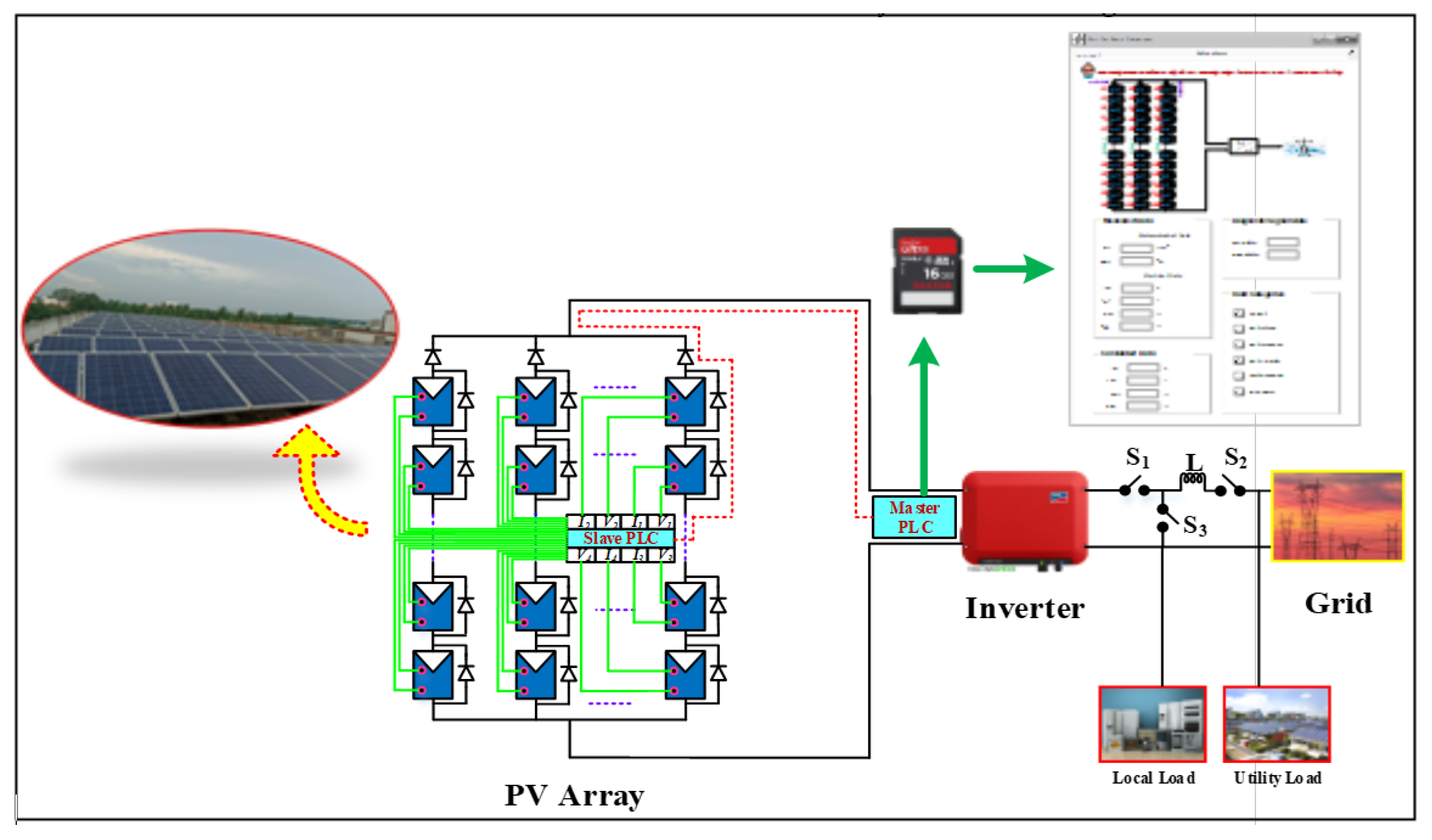
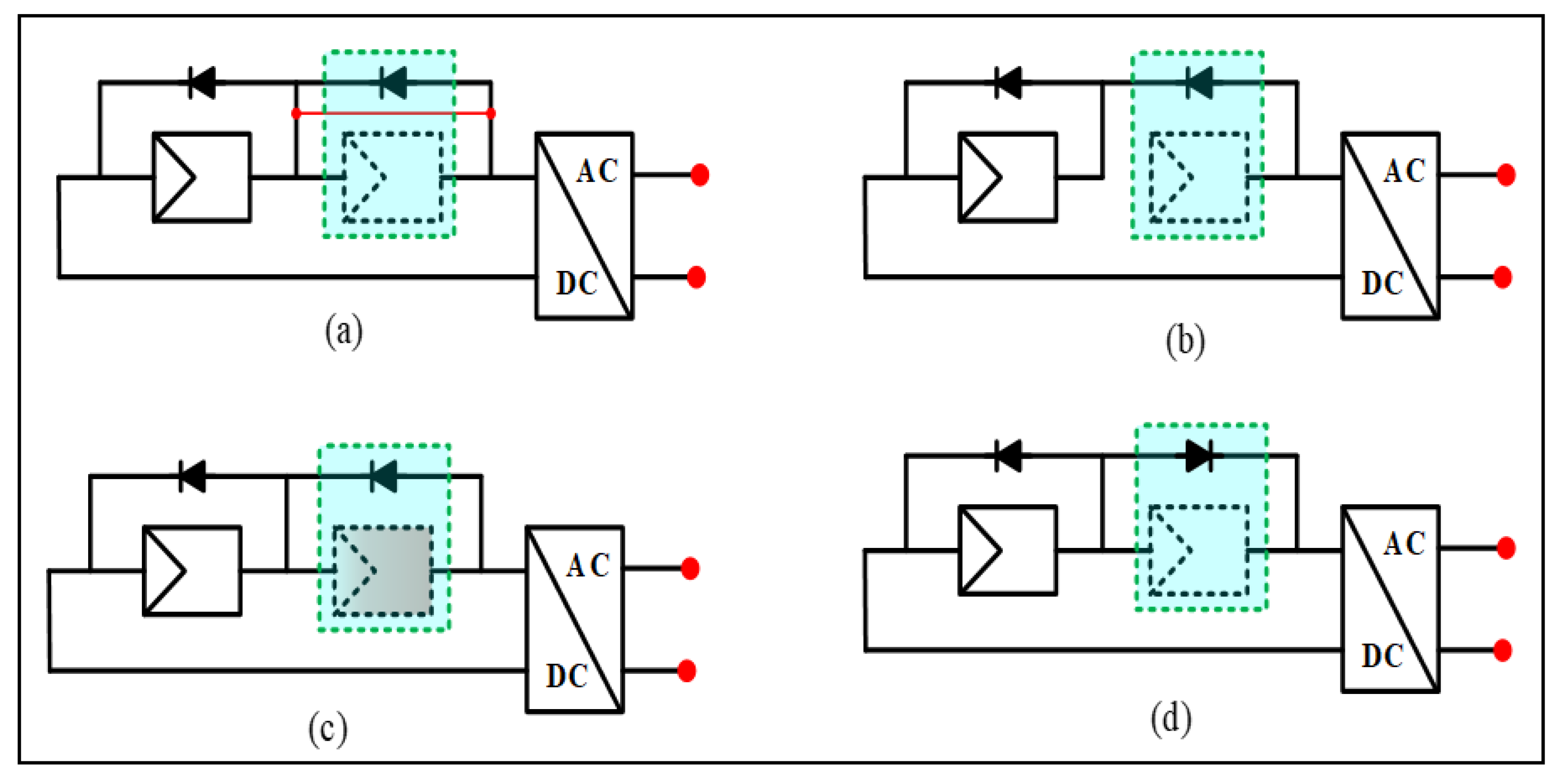
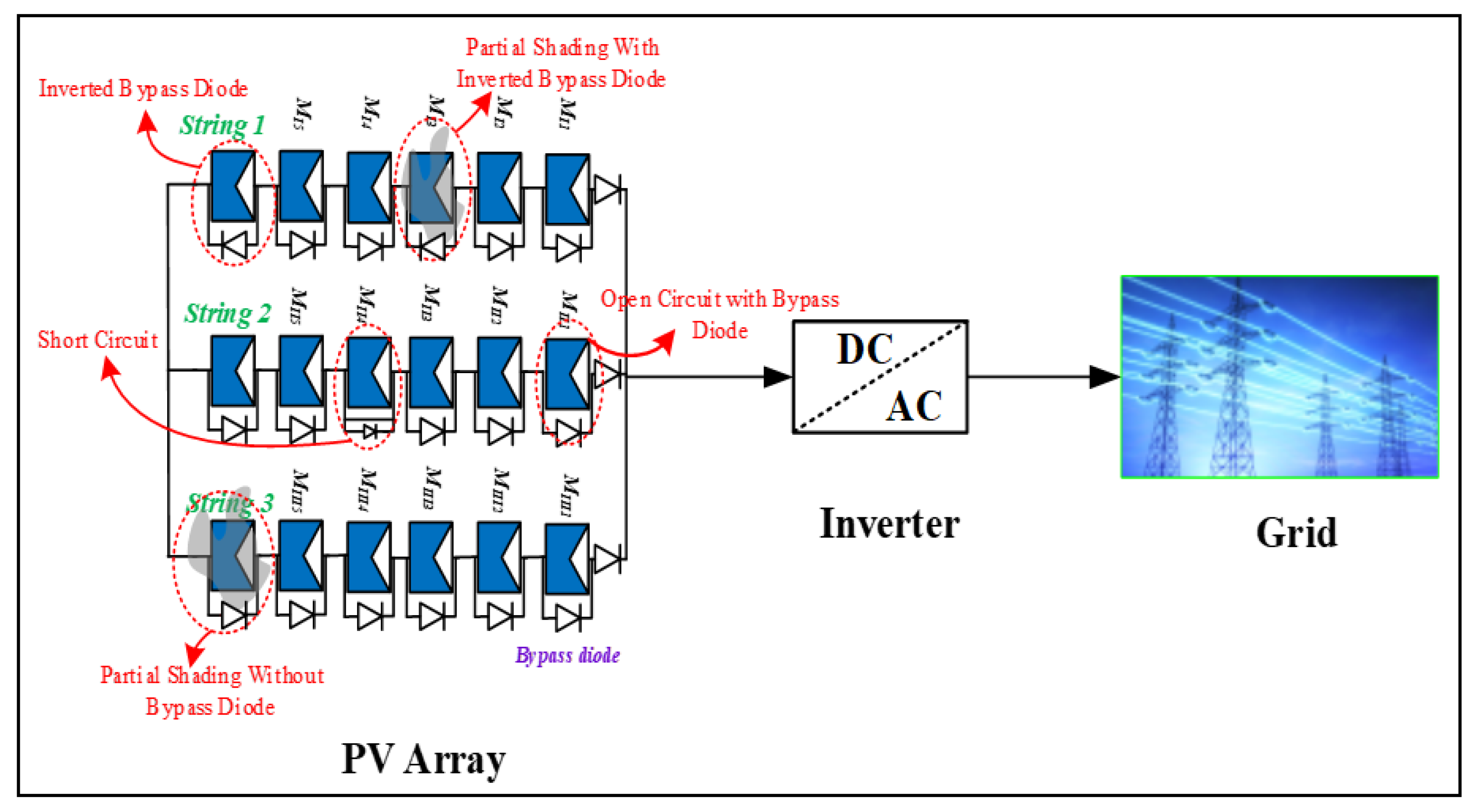

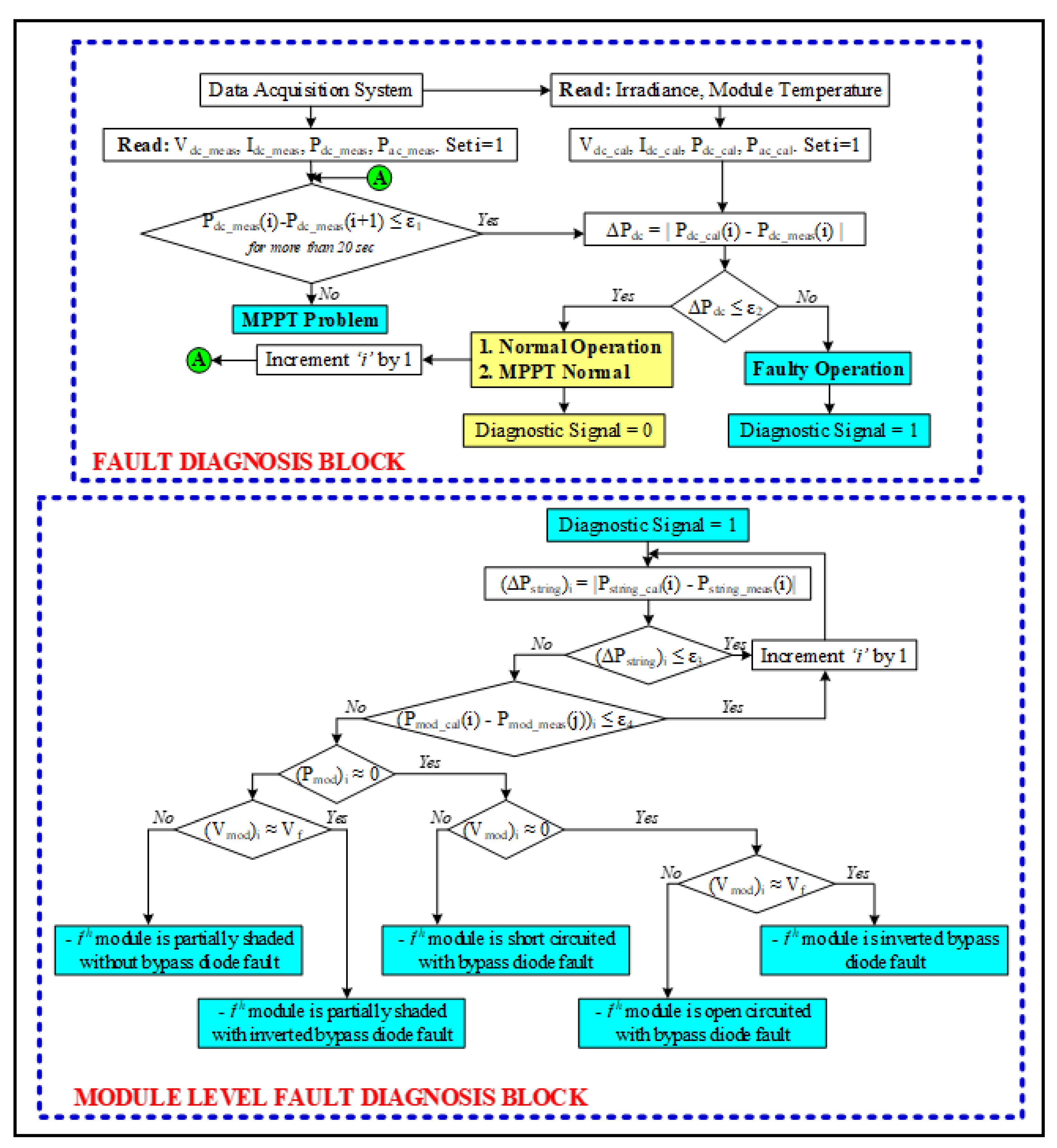
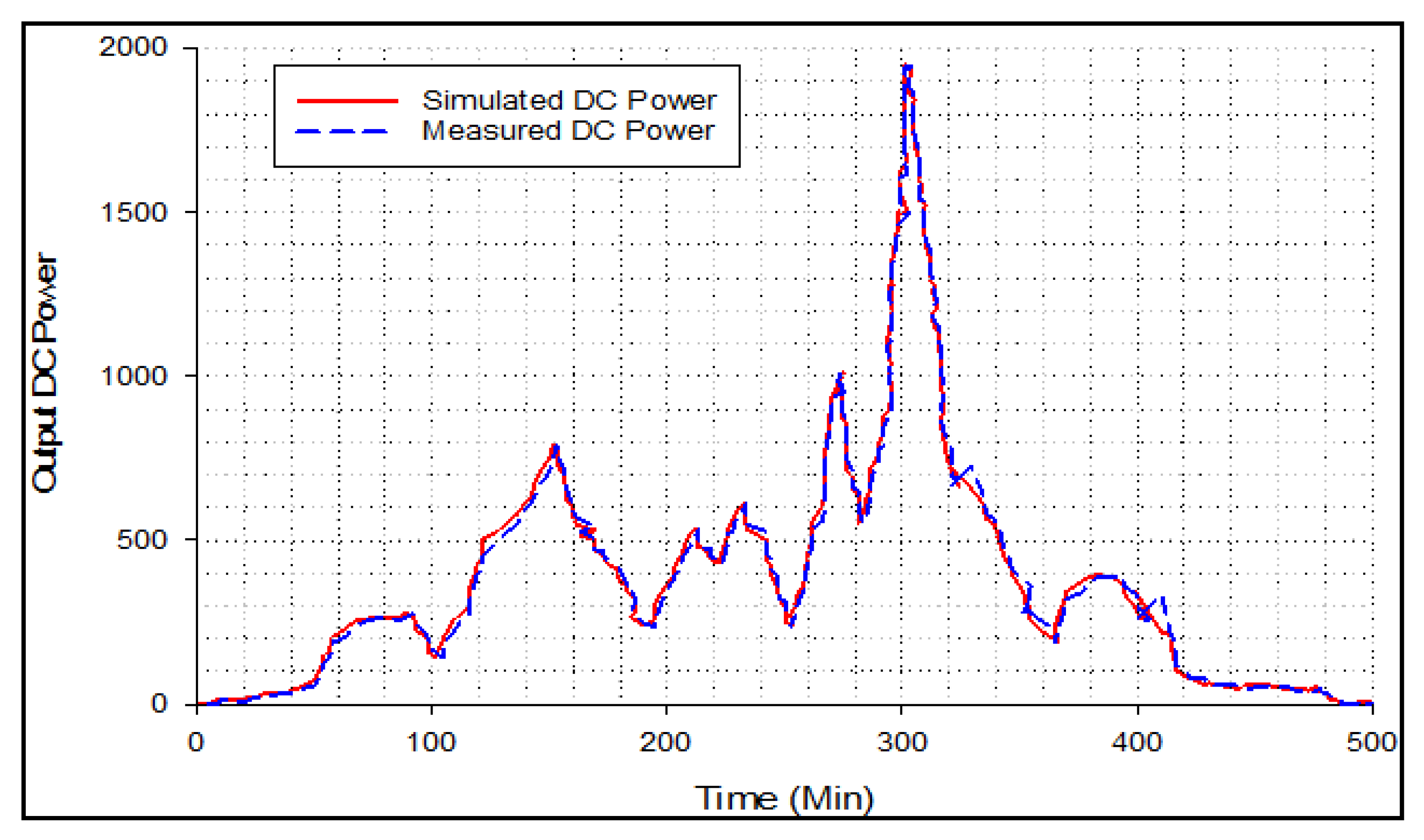
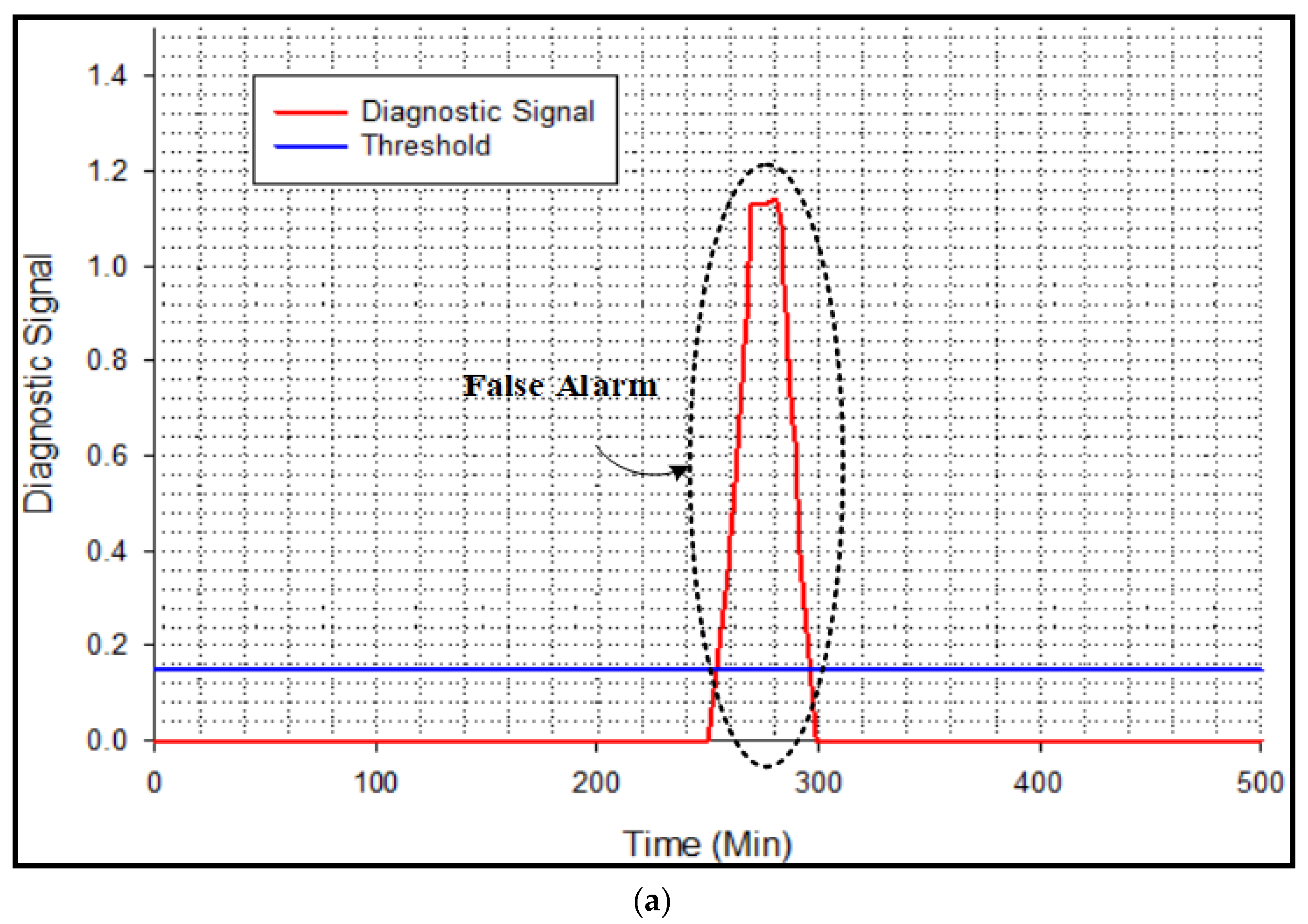

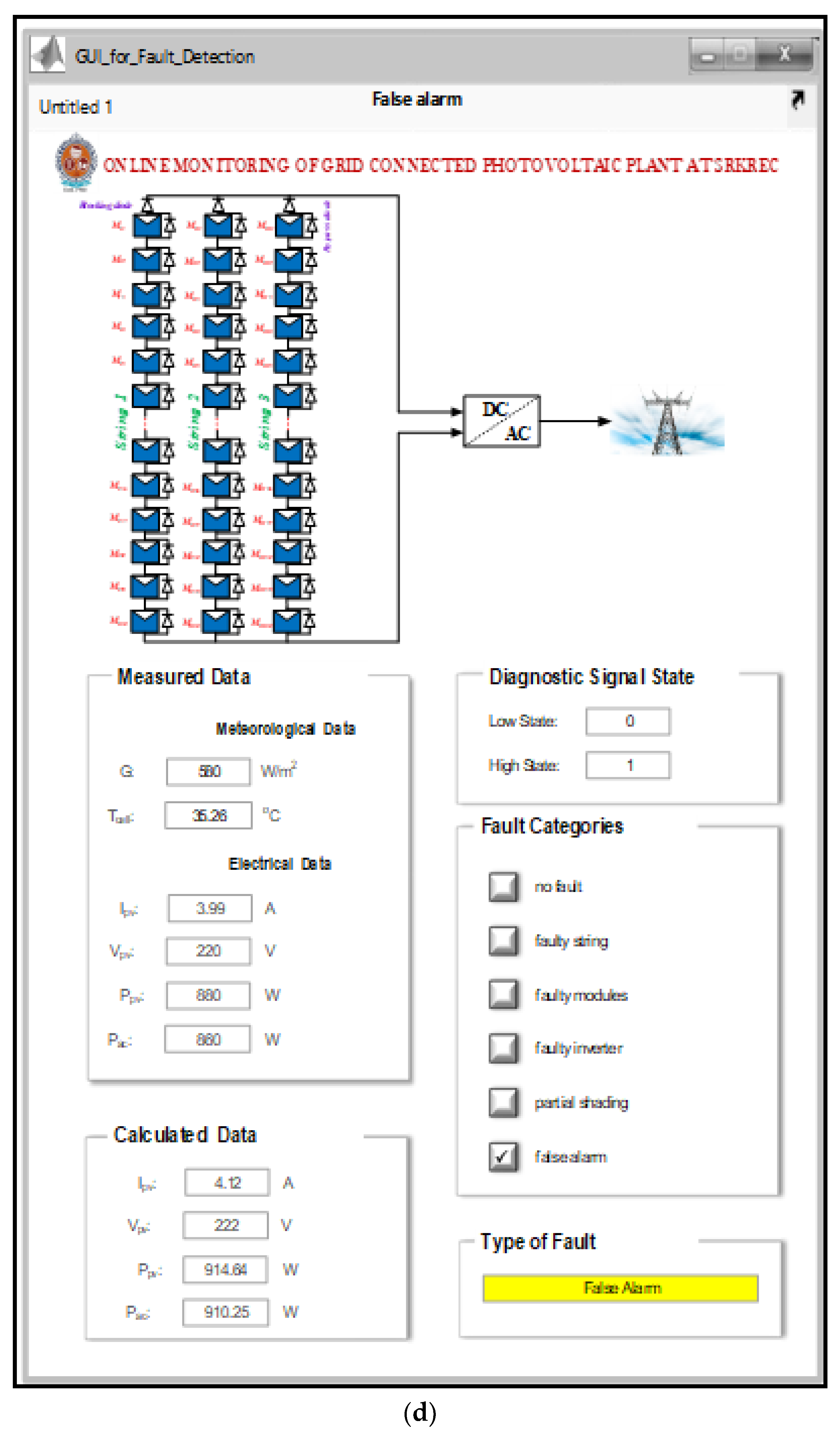
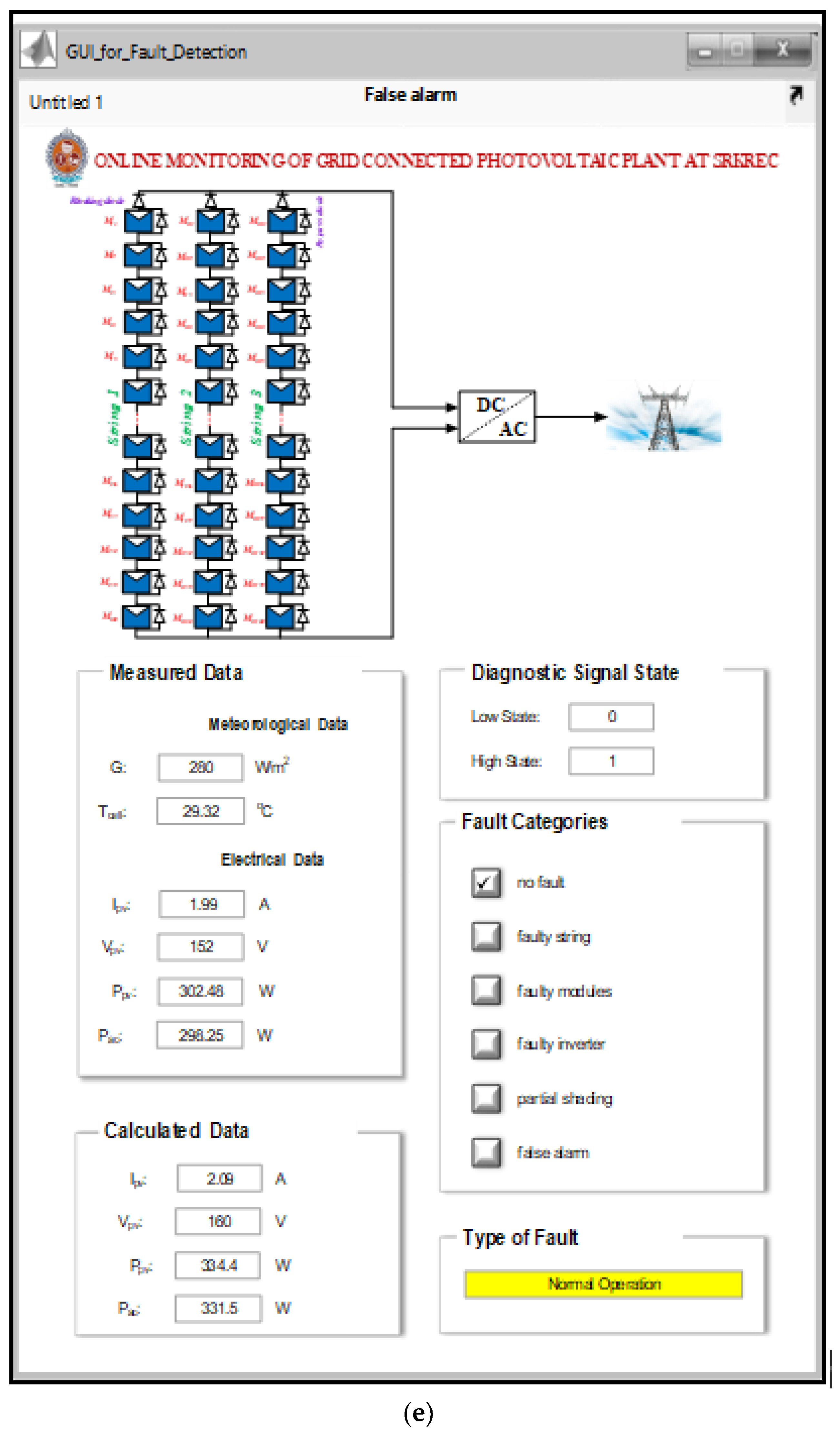
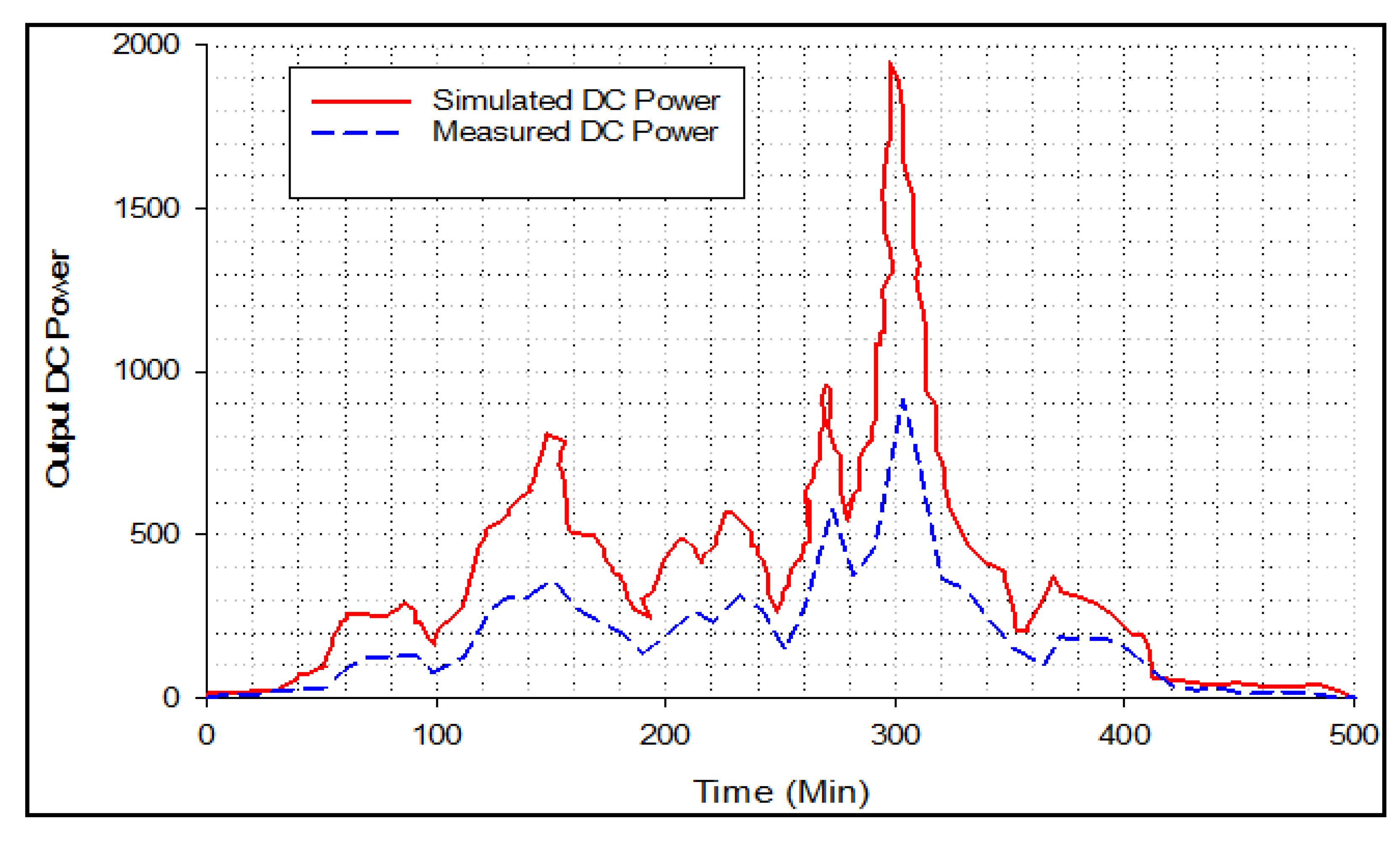
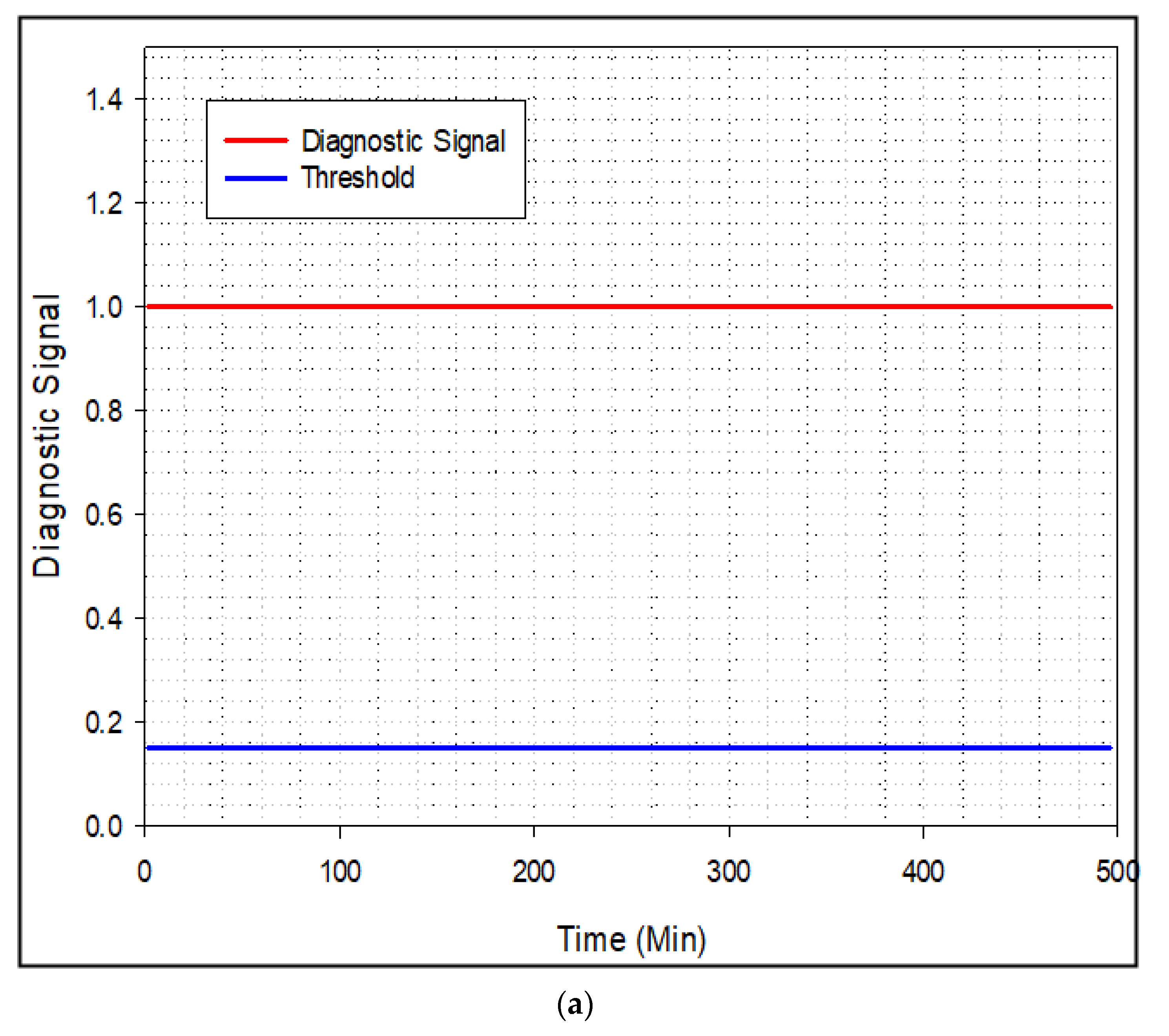
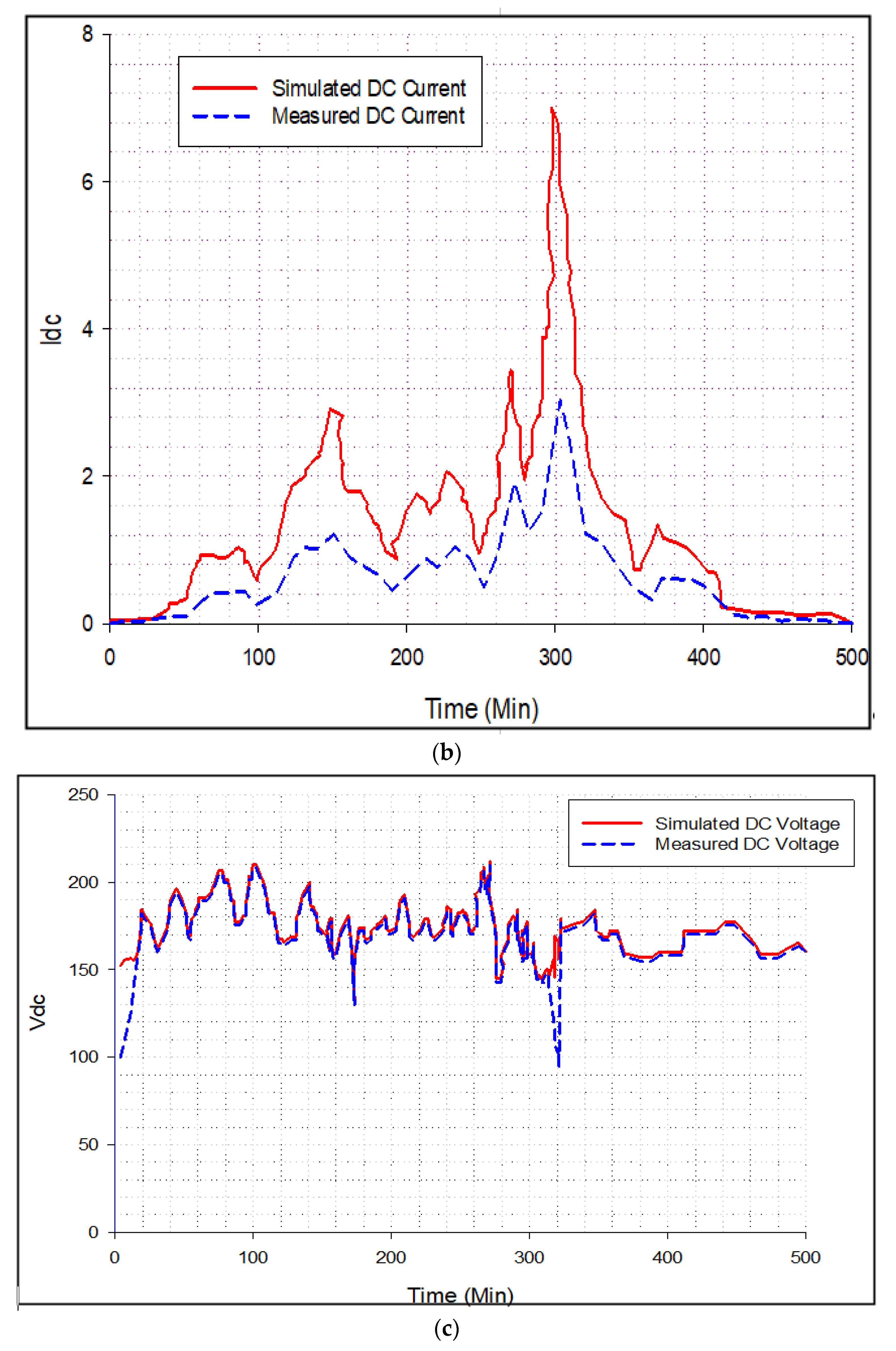
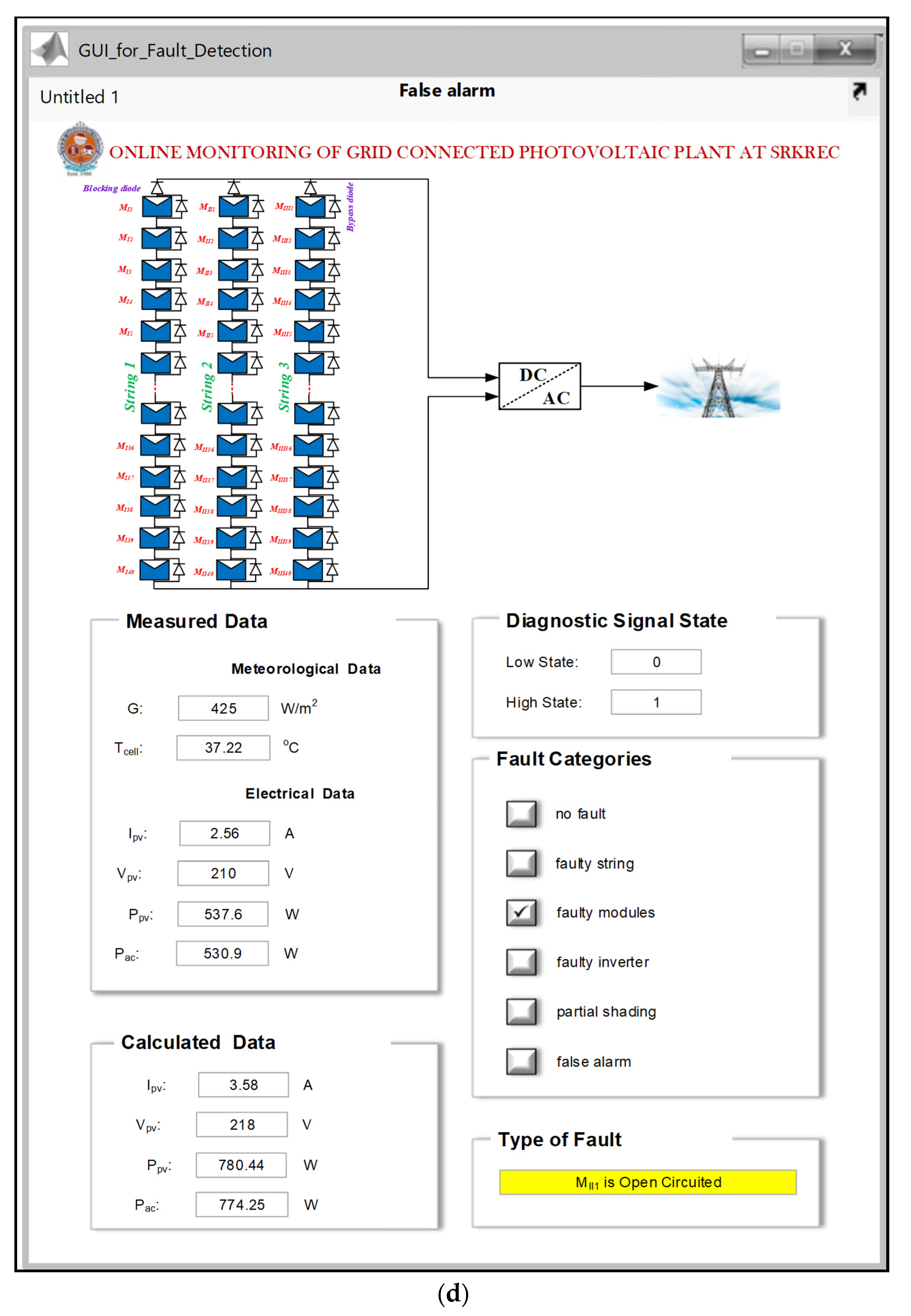
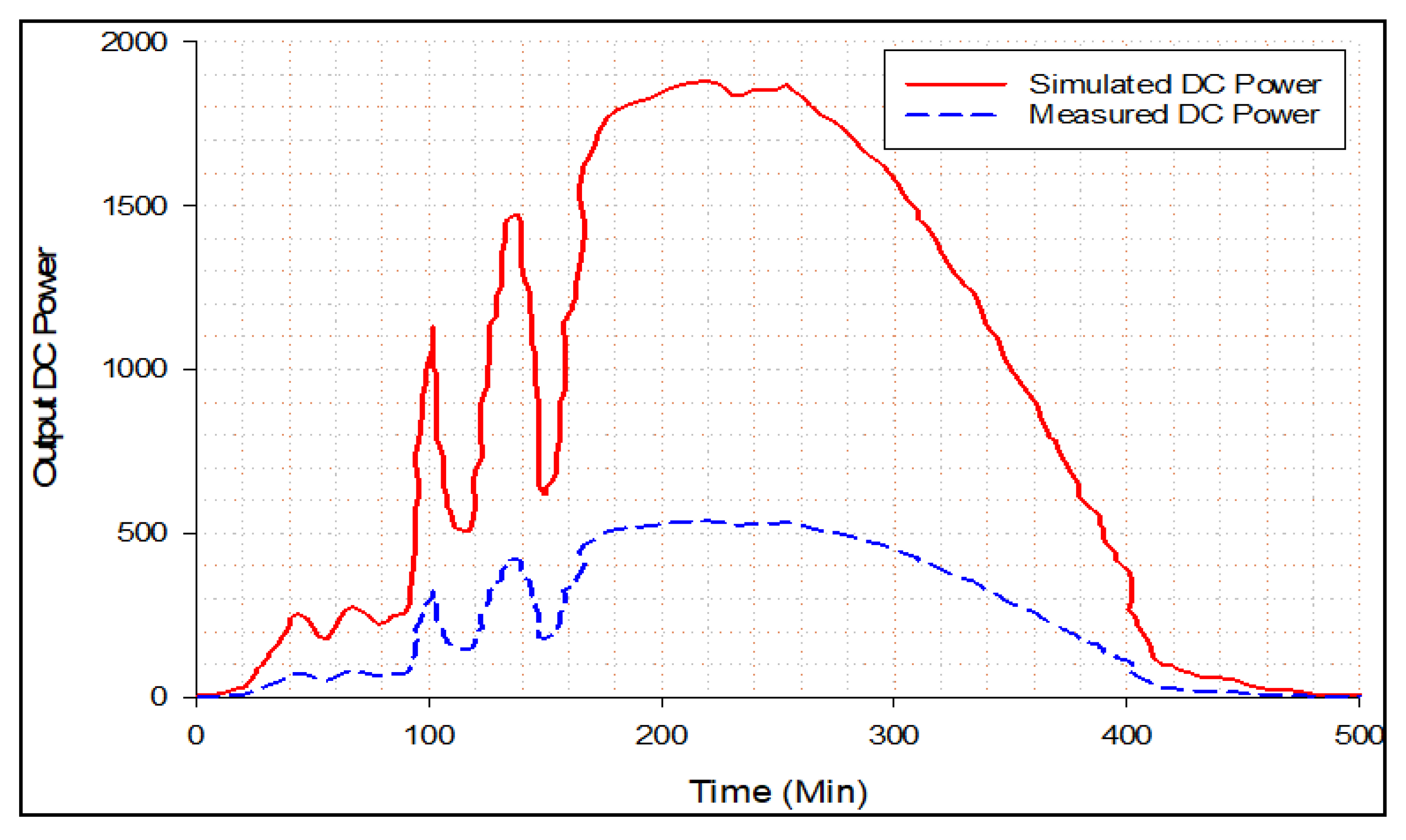
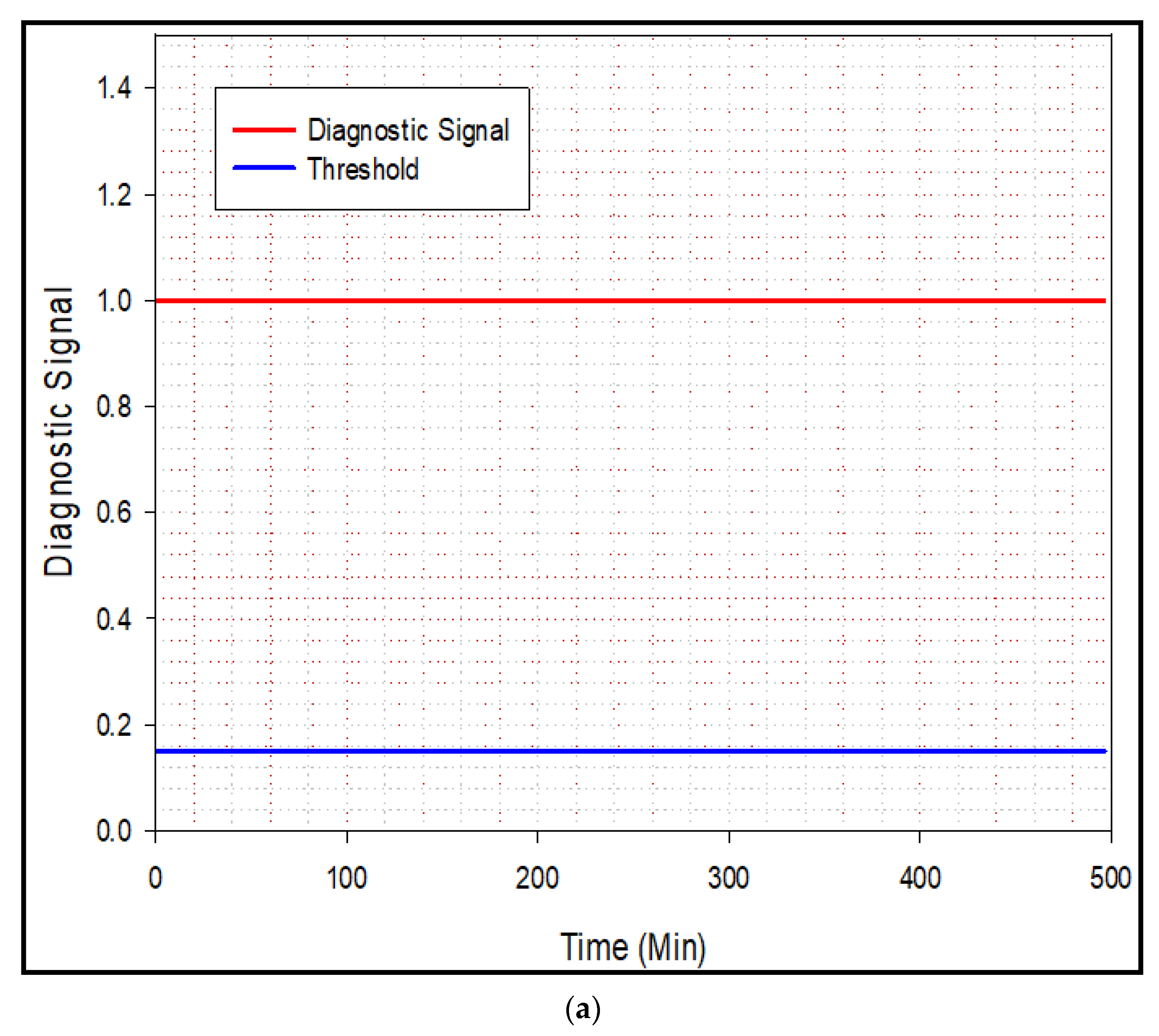
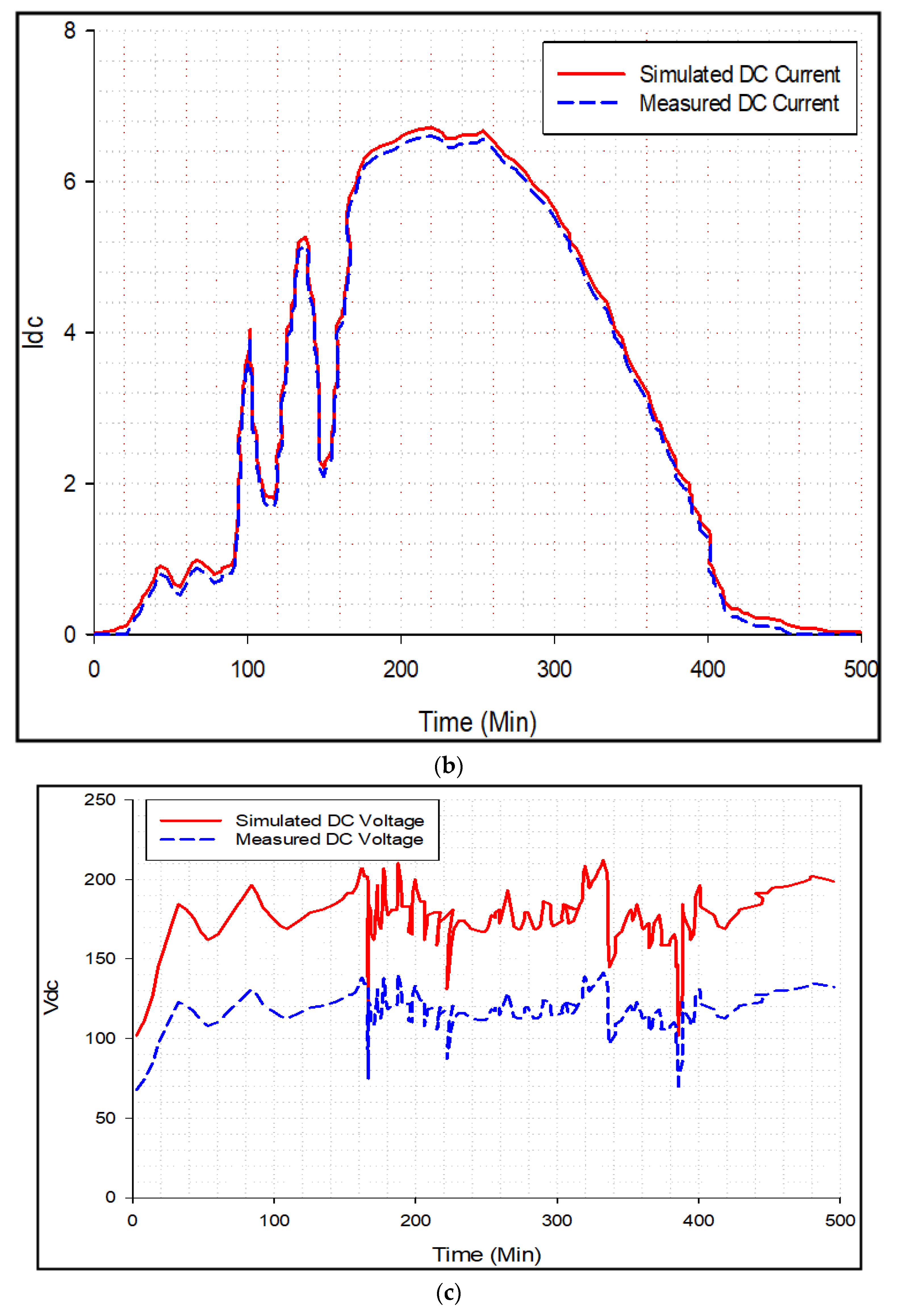
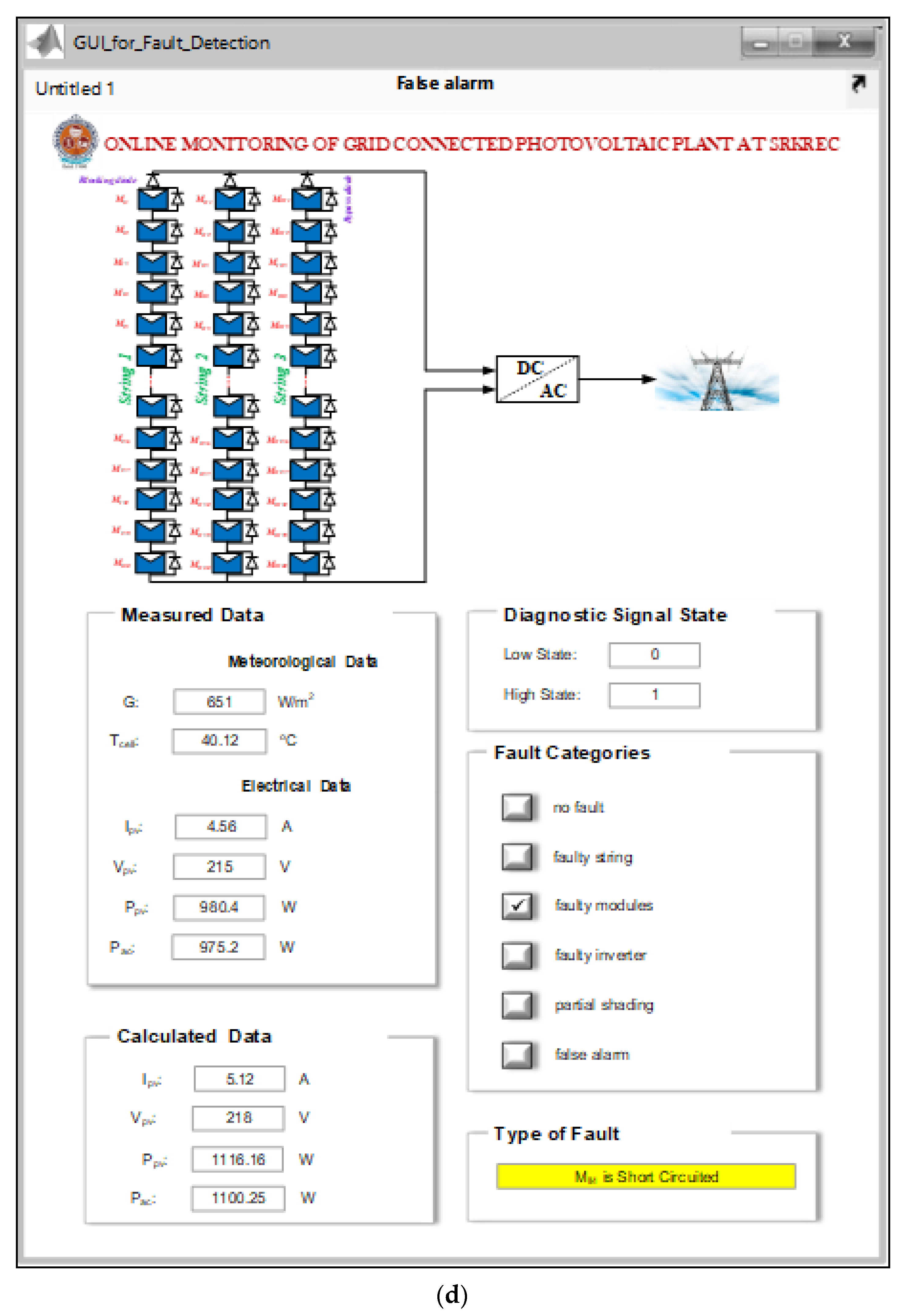


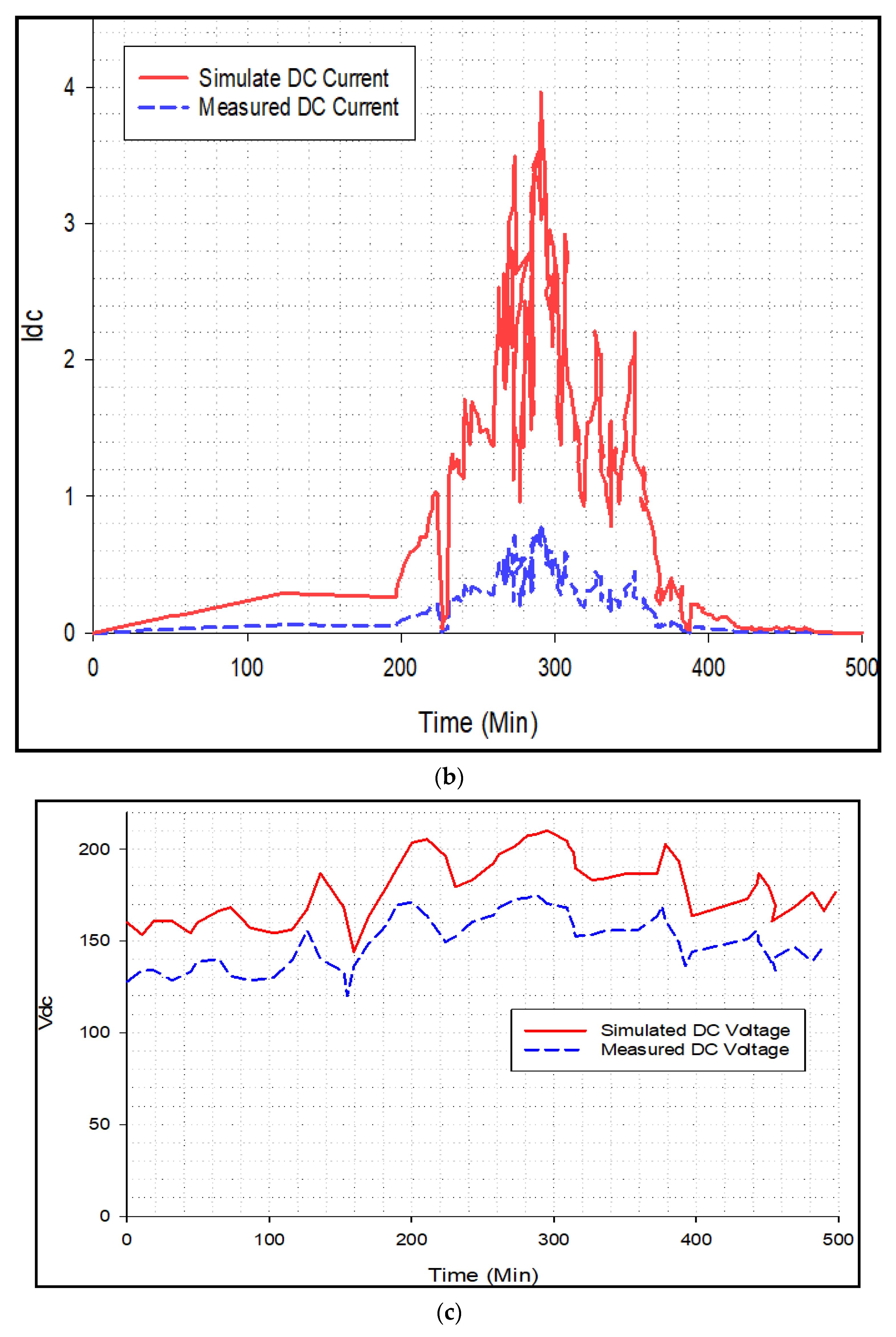
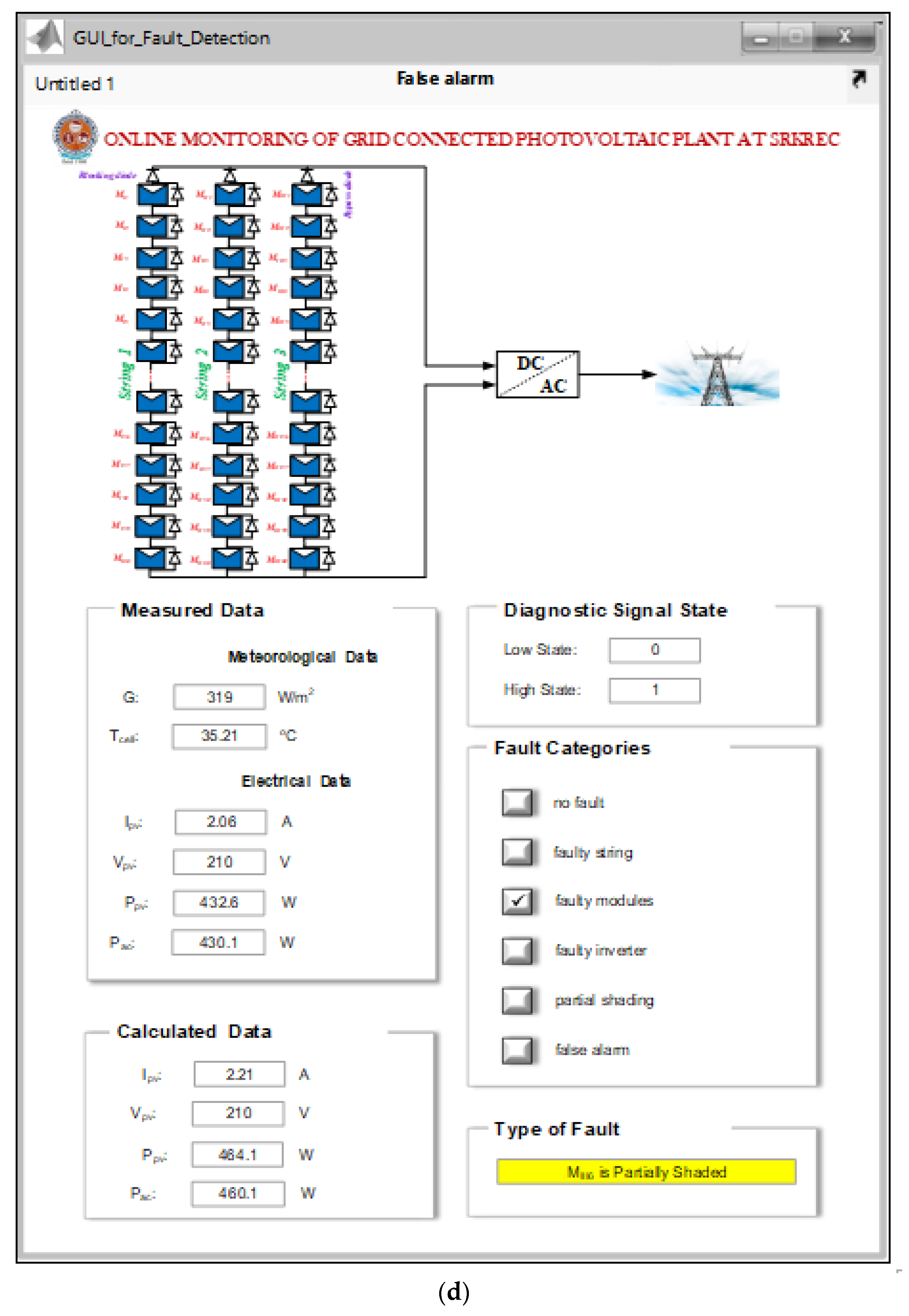
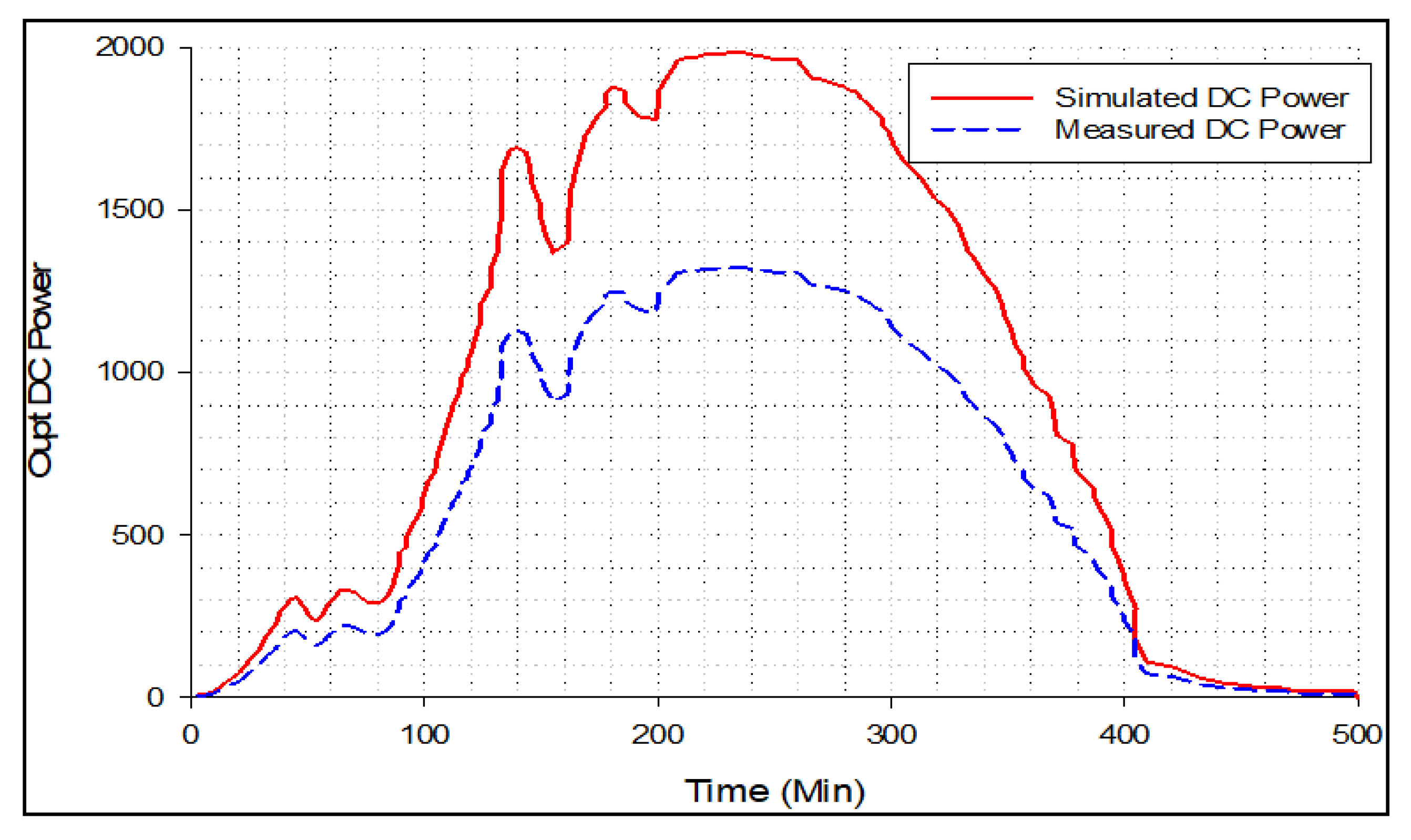
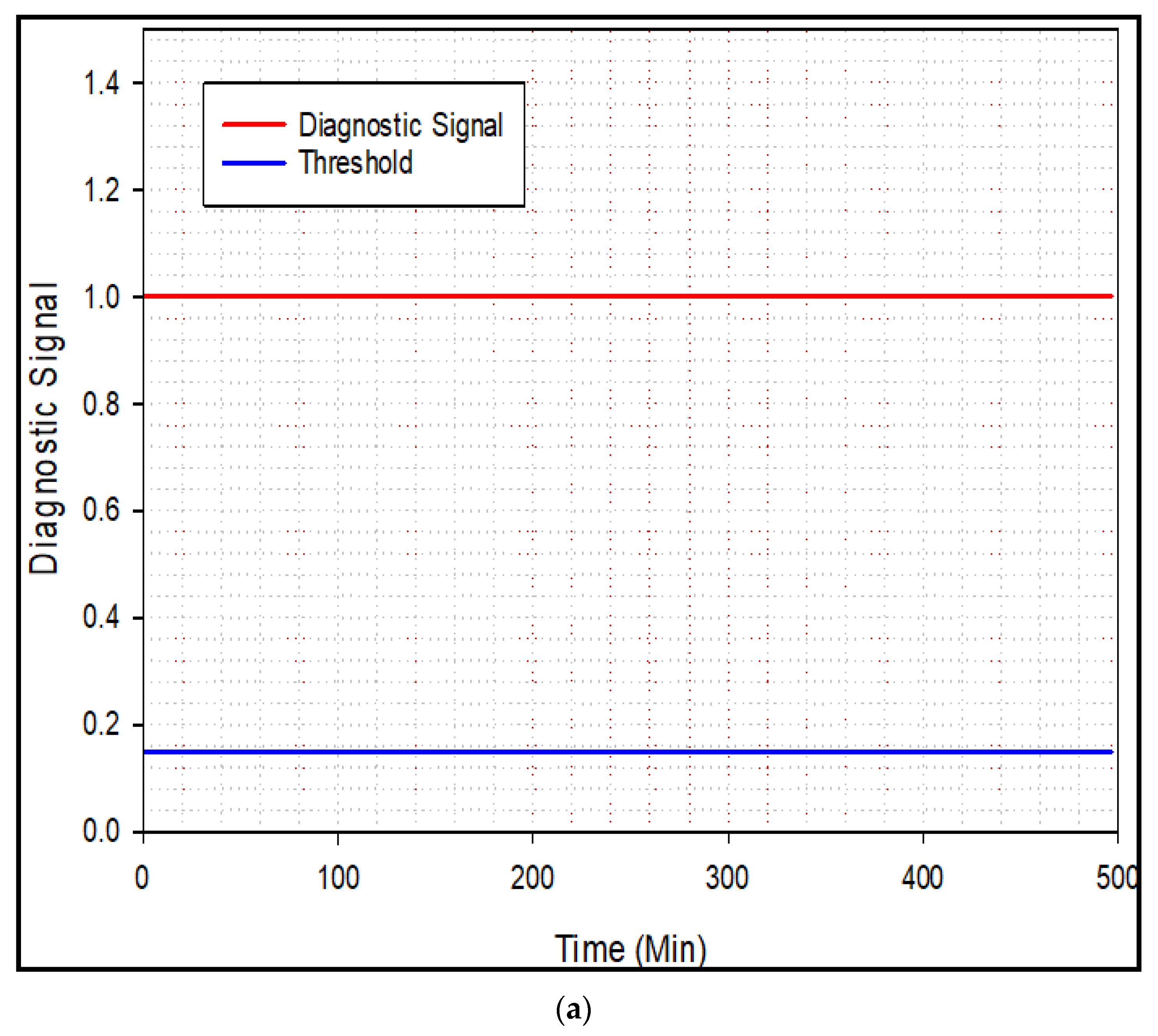
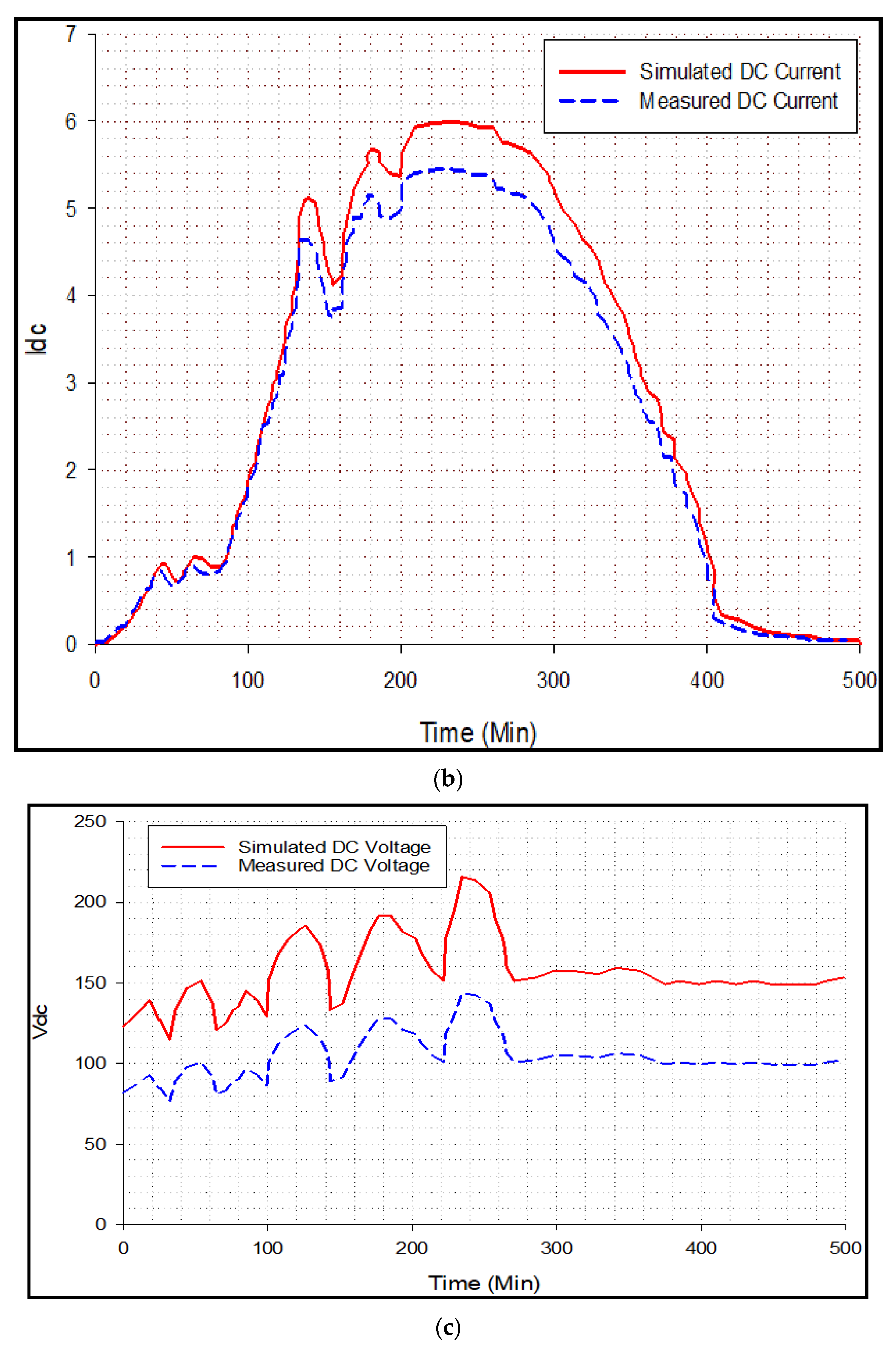
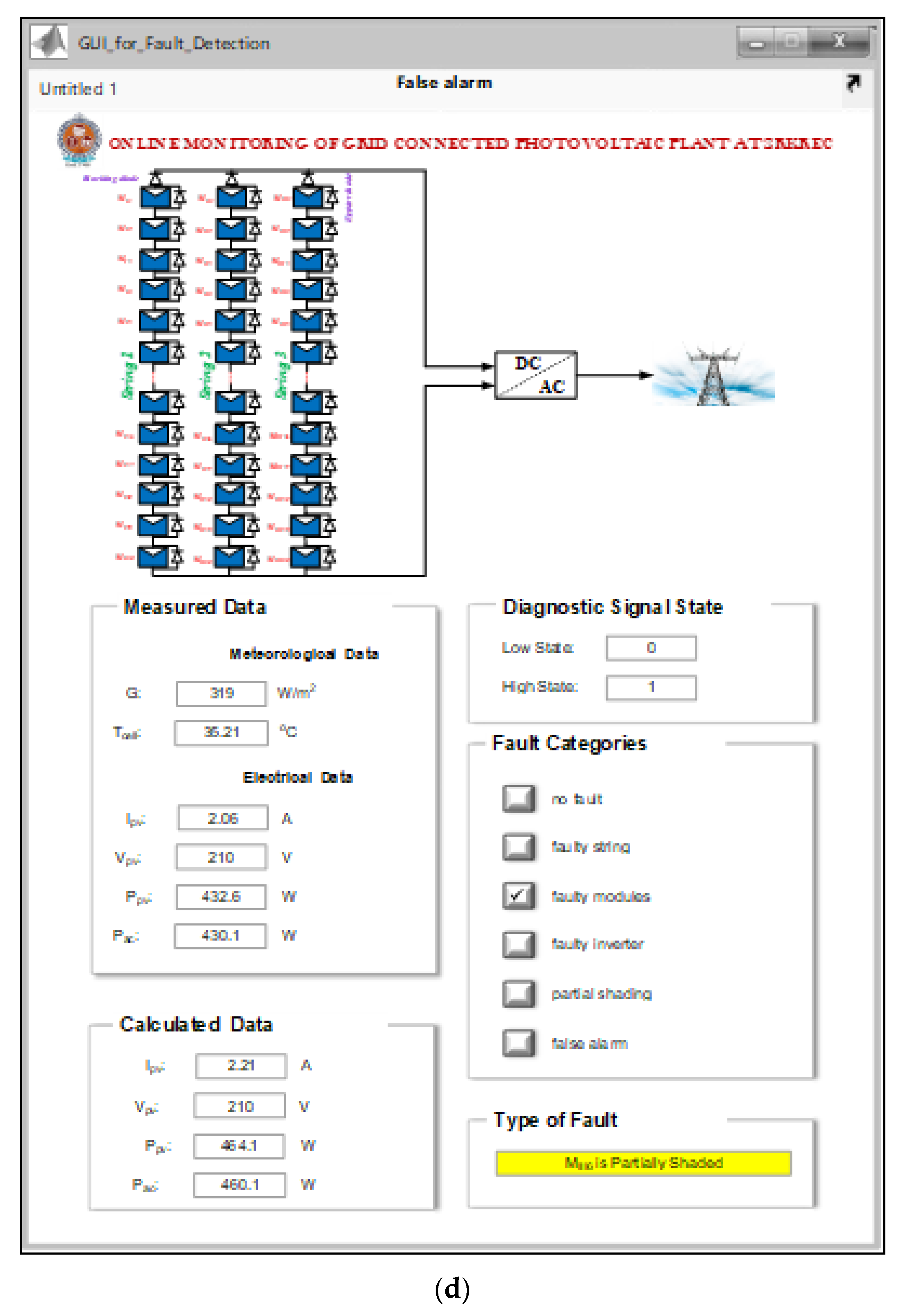
| S. No | Data Point | Units |
|---|---|---|
| 1. | Global Irradiance | W/m2 |
| 2. | Cell Temperature | °C |
| 3. | Array Voltage | V |
| 4. | Array Current | A |
| 5. | Module Voltage | V |
| 6. | Module Current | V |
| 7. | Inverter Output Voltage | V |
| 8. | Inverter Output Current | A |
| Type of Fault | Reason |
|---|---|
| Short-circuit |
|
| Open-circuit | |
| Partial Shading (with and without bypass diode) | |
| Inverted bypass diode |
| Type of Fault | Method Based on Power Losses Analysis | Proposed Method |
|---|---|---|
| String-I with module-1 is open-circuited | Faulty string | String-1 MI1 module is open-circuited |
| String-II with module-4 is short-circuited | Faulty string | String-2 MII4 module is short-circuited |
| String-III with module-6 is partially shaded | Faulty string | String-3 MIII6 module is partially shaded |
| String-I with module-6 has inverted bypass diode | Faulty string | String-2 MII4 module has inverted bypass diode |
Publisher’s Note: MDPI stays neutral with regard to jurisdictional claims in published maps and institutional affiliations. |
© 2022 by the authors. Licensee MDPI, Basel, Switzerland. This article is an open access article distributed under the terms and conditions of the Creative Commons Attribution (CC BY) license (https://creativecommons.org/licenses/by/4.0/).
Share and Cite
Aljafari, B.; Madeti, S.R.K.; Satpathy, P.R.; Thanikanti, S.B.; Ayodele, B.V. Automatic Monitoring System for Online Module-Level Fault Detection in Grid-Tied Photovoltaic Plants. Energies 2022, 15, 7789. https://doi.org/10.3390/en15207789
Aljafari B, Madeti SRK, Satpathy PR, Thanikanti SB, Ayodele BV. Automatic Monitoring System for Online Module-Level Fault Detection in Grid-Tied Photovoltaic Plants. Energies. 2022; 15(20):7789. https://doi.org/10.3390/en15207789
Chicago/Turabian StyleAljafari, Belqasem, Siva Rama Krishna Madeti, Priya Ranjan Satpathy, Sudhakar Babu Thanikanti, and Bamidele Victor Ayodele. 2022. "Automatic Monitoring System for Online Module-Level Fault Detection in Grid-Tied Photovoltaic Plants" Energies 15, no. 20: 7789. https://doi.org/10.3390/en15207789
APA StyleAljafari, B., Madeti, S. R. K., Satpathy, P. R., Thanikanti, S. B., & Ayodele, B. V. (2022). Automatic Monitoring System for Online Module-Level Fault Detection in Grid-Tied Photovoltaic Plants. Energies, 15(20), 7789. https://doi.org/10.3390/en15207789








